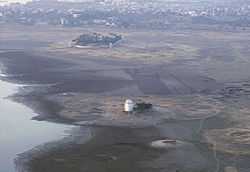Udaipur Solar Observatory
| Udaipur Solar Observatory | |
|---|---|
|
In December 2002 during a dry season | |
| Coordinates | 24°36′16.52″N 73°40′27.08″E / 24.6045889°N 73.6741889°ECoordinates: 24°36′16.52″N 73°40′27.08″E / 24.6045889°N 73.6741889°E |
| Established | 1976 |
| Website | Physical Research Laboratory |
The Udaipur Solar Observatory (USO) is in Udaipur, Rajasthan in India on an island in the Fateh Sagar Lake. The sky conditions at Udaipur are quite favourable for solar observations. Since the observatory is situated amidst a large mass of water, air turbulence which occurs due to ground heating by sun's rays is decreased. This improves the image quality and accuracy (average between 1-2 arc seconds).
History
The observatory was built in 1976 by Dr. Arvind Bhatnagar following the model of the Solar Observatory at Big Bear lake in Southern California. Later, he was joined by Dr. Ashok Ambastha in 1983 and subsequently by many others at different stages who have continued further contributing to its development.The observatory is currently headed by Dr.P. Venkatakrishnan.
Telescopes
Utilizing a variety of telescopes, USO is known for its solar observations, which include high-resolution solar chromospheric, magnetic field, velocity, and spectral observations, for studies pertaining to solar flares, mass ejections, and the evolution of solar active regions. USO fills the large longitudinal gap between Australia and Spain, and provides a link for continuous solar coverage in international collaborative programs, including the Global Oscillations Network Group (GONG). Since 1981, USO has been managed by the Physical Research Laboratory, Ahmedabad, for the Department of Space, Government of India.
The city of Udaipur was planned around a set of man-made lakes created from rain water. However with population pressure and with poor rainfall, the water in these lakes has been steadily dwindling. In 1975, Fateh Sagar flooded its adjoining neighborhoods; In 2003, it was completely dry, and one could walk to the USO (see photo). As of 2006, the lake is full again and you need to take a boat to go to the observatory. With particularly good rains in 2010, the observatory is again surrounded by water and taking a boat is the only option left.
